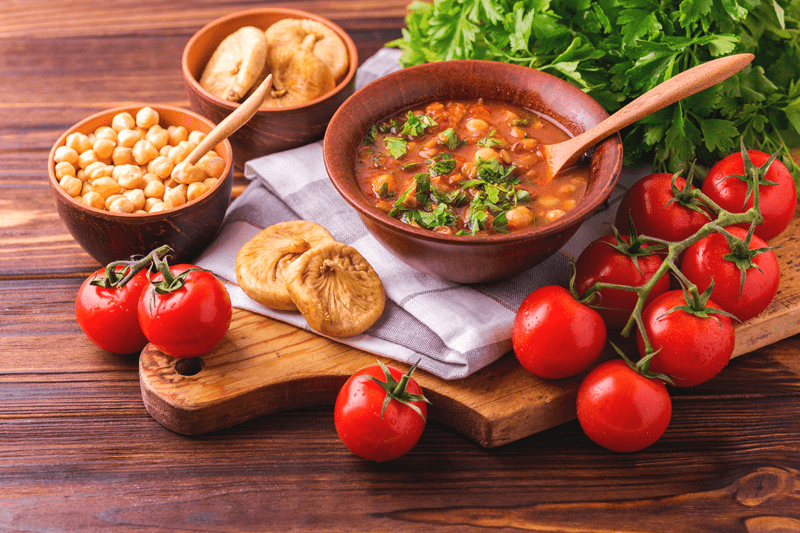
Algerian cuisine is an impressive representation of the country’s rich cultural heritage and geographical diversity. Closely linked to the food culture in Algeria, it incorporates influences from Arab, Berber, Ottoman, and French traditions to produce dishes that are flavorful and comforting. From rich stews to pastries stuffed with sweet goodness, Algerian traditional dishes offer an array of textures and flavors that distinguish this North African treasure.
Across various areas of Algeria, eating is an integral part of family life and a significant aspect of celebrations. Meal preparation is done carefully and often utilizes centuries- and generations-old Algerian recipes. Coastal areas of Algeria in the Mediterranean focus on vegetables and fish. In contrast, inland and desert areas focus on grains, dates, and spices. In either case, a remarkable collection of Algerian flavors characterizes North African cuisine.
The essence of food culture in Algeria is collective. It is customary to share food as a sign of hospitality, unity, and generosity. Food is usually served family-style or shared from a large platter, with everyone eating from the same dish.
Foodways reflect Algeria's history as a meeting place of civilizations. Berber cooking methods are the basis for most of the cuisine. Arab spices, Ottoman pastries, and French baking have all influenced the culinary landscape. Olive oil, grains, and fresh herbs form the basis of the Algerian kitchen, offering a healthy and hearty meal.
In the home, hospitality is sacred. Guests will always be offered mint tea and sweets. No one should leave the table hurt. In this generous and inclusive approach to food, we can see not only traditional Algerian cooking but also its cultural identity.
Traditional Algerian cuisines combine simplicity and sophistication. Many recipes involve simply cooking for long periods, which enhances the depth and flavor of the cookbook, turning everyday ingredients into incredible culinary experiences.
Some signature dishes are
Each of these dishes tells a story of the Algerian landscape, climate, and natural exchange that has occurred over centuries. Locals enjoy this food at home, in restaurants, or in the market. These will be the foods that connect modern Algeria with its ancient civilizations!
Each delectable dish has roots in traditional Algerian recipes that required patience and time. Most of these dishes involve meticulous and labor-intensive preparation, such as hand-rolling couscous, slow-cooking sauces, and blending fresh spices. In most households, women learn to cook by watching their elders—very rarely, as for the rest of us, are recipes written down. That is not how we learn to cook. Women learn to cook with their sense of touch, taste, and instinct. This oral tradition has preserved the authenticity of Algerian traditional recipes and cuisine through the generations.
Ingredients that are often used in Algerian recipes:
All these ingredients work harmoniously together to form layers of Algerian flavor—earthy, spicy, and subtly sweet. The result is food that gives soul but also engages all the senses.

The essence of Algerian cuisine lies in its incredible array of spices. Spices flavor food, but they also communicate the nation’s trade history and cultural exchanges with its neighbors. Common spices found in Algerian food:
The magic of these spice blends is what distinguishes the flavors of Algeria, providing warmth and richness to the food. With a bit of care and creativity, any standard couscous or stew becomes something exceptional.
The enormous physical geography of Algeria shapes its food traditions. From the Mediterranean coast to the monumental geography of the Sahara Desert, each part contributes ingredients and cooking methods that are distinctly Algerian.
The regional variety of these areas has contributed to the diversity and fluidity of Algerian cuisine. Regardless of where you travel throughout Algeria, you will encounter neighboring lands that are luxurious, generous, and representative of the country's naturally occurring characteristics.
Algerian food is part of the wider North African culinary tradition, sharing some features with neighboring countries but remaining distinctly Algerian. Like Moroccan food and Tunisian food, Algerian cuisine's mainstays are couscous, stew, and pastry. However, the flavors are slightly more muddled and have a bit of spice but less emphasis on sweetness.
Things North African food has in common include:
However, the local specifics—such as Algeria's mild heat and earthy flavors—allow Algerian flavors to stand out in the North African region.
In Algeria, meals are traditionally a family, community, and spiritual event. Special dishes during religious holidays, weddings, and harvest seasons break up the daily routine.
These traditions reflect the conviviality that lies at the foundation of Algerian food culture, or food as the connector of generations and communities.
No discussion of Algerian cuisine would be complete without mentioning its delectable sweets. Dessert is often a social affair, served with mint tea and shared among family and guests.
Popular Algerian sweets include:
These desserts showcase the skillful blend of ingredients, such as nuts, honey, and spices—hallmarks of Algerian recipes that celebrate joy and hospitality.
Algerian cuisine is a celebration of history, culture, and connection. Through traditional Algerian dishes and time-honored recipes, this remarkable North African cuisine invites you to savor the warmth and depth of Algerian flavors, offering an experience that nourishes both body and soul.
This content was created by AI